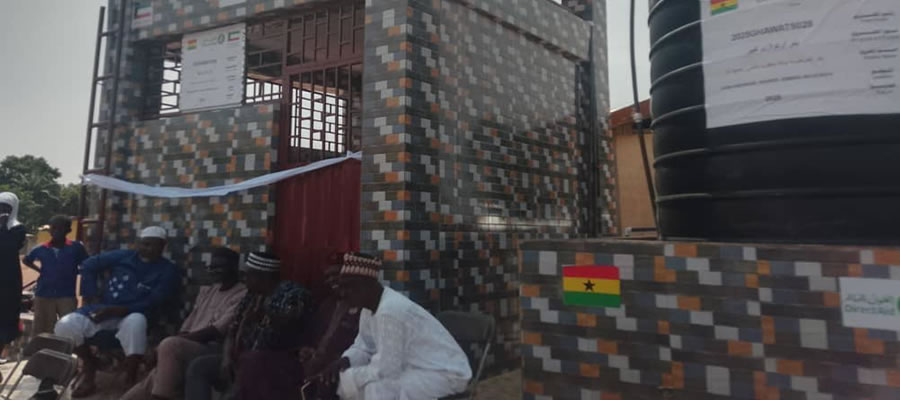

Commerce is generally seen to be a sub-sector of the service sector. It employs basically 22.1% of the labour force. Commerce is basically categorized into retailing and wholesaling. In Ejisu-Juaben District, 83.4% of the people in this sector are retailers whiles 3.4% are wholesalers. The remaining 13.4% of the people in this sector are petty traders. This is so because the income level of the people is low and inadequate for wholesaling. People in the District generally deal in manufactured goods which include a wide variety of items ranging from clothing to shoes, toys, etc.
Financing of Activities
For the employers; who forms 91.7% of the people in this subset, sources to start up capital is sparsely distributed within the range of below five hundred thousand and over two million cedis (¢500,000 - ¢2,000,000). 43.3% of tern earned between the range of ¢501,000 - 2,000,000). This is followed by 31.7% of the people, and these are those whose start up capital is two million and above (¢2,000,000+). The last among them is those whose start up capital was below five hundred thousand cedis (¢500,000). According to the survey, the average start up capital is one million and seventeen thousand, four hundred and fifty-five cedis (¢1,017,455).
Sources of Start Up Capital
The major source of start up capital for financing activities is basically through personal savings and this accounts for 53.4%. Some of the people finance their activities through loans from financial institutions (3.2%) whiles others get their financial support from family members (41.7%). The least proportion among them is those who have sources through friends. They constituted 1.7% of the people.
Access to Credit
Considering this sub sector, access to credit facilities is available for only 25% of the people. This implies that 75% of the people don’t have access to any form of credit facility. The above information portrays why many of the activities are normally carried out on small scale basis and also informal.
Tax Payment
Majority (78.4%) of the people pay tax, with the rest, which is a little above 21% constitute those who do not pay tax contribution to development. This is because these commercial actors strive optimise profit and therefore sees tax payment unfriendly. Most (63.9%) of the tax payers contributes less than one hundred thousand (¢100,000). This is followed by those who contribute between ¢101,000 - ¢200,000.
They form 32% of the tax payers. The least among them are those who contribute over two hundred thousand cedis (¢200,000+). They also form 4.1 % of the tax payers. This is as a result of the fact that most of them are running small scale commercial activities thus affecting their tax contribution adversely. The average tax paid is ninety-four thousand, eight hundred and forty cedis (094,840).
Saving Pattern
Almost 83.4% of the people have cultivated the habit of saving either at the banks, or with the various "susu" schemes, or personally, according to the survey. The remaining 16.6% do not save their income. Considering the means of savings, it was realized that 48% of those who save are saving at the various banks. Also 32% of them save with the numerous "susu" schemes, whiles 20% of them save personally. This implies that, most of the people save with the banks which can serve as the guarantee for the acquisition of loans.
According to the survey, the amount saved per month by the people working in the commercial sector ranges between below one hundred thousand cedis (¢100,000) and above two hundred thousand (¢200,000+) with 44% of them saving more than ¢200,000 per month. This is followed by those who save between one hundred and one thousand and two hundred thousand cedis (¢101,000 - ¢200,000). Few of them (14%) save below one hundred thousand cedis (¢100,000). The average amount saved per month is two hundred and twenty-four thousand, two hundred and ten cedis (¢224,210).
Industry
The industrial sector is the smallest sector of the District economy. It employs only 3.1% of the total labour force. This sector can be said to be an emerging sector possessing the capacity to absorb a greater percentage of the labour force if adequate measures are put in place to propel its growth. Most industries in the District produce on a small scale. This is because they have low production capacity in the form of machinery, labour and other inputs. A good number of the industries (73.7%) obtain their raw materials outside the district. The remaining 26.3% obtain theirs within the districts. This has adversely affected the cost of production of these industries. There is therefore the need to put in measures to produce adequate raw materials to feed the existing industries and also attract new ones.
Type of Industry
The type of industrial activities in the District can be categorised based on their primary input or raw material. The wood industry is the largest (42.1%). and includes sawmilling and carpentry. This is followed by kente weaving (36.8%). Metal-based manufacturing industries include welding and steel bending constitutes 21.1% of the industrial workers.
Marketing
Marketing is an essential part of the production process for which the availability or otherwise of a ready market, has significant consequences on the output and incomes of the producers. It was realized that 63.2% of the respondents market their goods within the District, while the remaining 26.8% of them commute to other parts of the country to market their goods. Majority of these traders commute to Kumasi Central Business District to market their products.
Sources of energy for Industry
According to the survey, 83.5% of the industrialists make use of electricity as their major source of energy for the running of their industry, whereas the rest (16.5%) resort to the use of petrol/diesel. The problem of power fluctuation therefore affects the productivity of those industries which use electricity as their main source of energy
Employment Status
Majority of the people working in the industrial sector are employers on their own. They form 89.5% of the entire labour in the sector. The rest (10.5%) have been employed by the owners of the various industries. This implies that majority of the entrepreneurs are employers who employs the remaining proportion. Labour employment by most industries in the District is through apprenticeship. Employment of paid labour is very minute
Sources of Start Up Capital
The predominant source of the start up capital for the industrialists is through their own personal savings. This forms 64.7% of them. This is followed by those who obtained theirs through remittances from their relatives, with a percentage of about 23.6% of the industrialists. The least among them are those who obtained them through their friends of loans from any of the banking institutions available.
They form 5.8% each. Considering the amount they use to start up their industry, it was realized that majority (64.7%) of them starts their industry up with capital ranging between five hundred and one thousand and two million cedis (¢501,000 -¢2,000,000). Some also start up with an amount of more than two million cedis (¢2,000,000+). They form 5.8%. The rest (29.5%) of the industrialists start their industry with an amount less than five thousand cedis (¢500,000). The average start up capital for the industrial sector is one million and eighty-eight thousand, five hundred and fifty-eight cedis (¢1,088,558).
Access to Credit
Most the people engaged in the industrial sector of Ejisu-Juaben District do not have access to credit facilities to enable them expand their activities to increase production. About 84.3% of them have no financial credit.
Tax Payment
About 79% of the people engaged in the industrial sector pay taxes on their businesses. This implies that the remaining 21% of the entrepreneurs in the District do not make tax contribution to the development of the District and the nation as a whole. About 6.6% of the tax payers pay tax ranging between one hundred and one thousand and two hundred thousand cedis (¢101,000 - ¢200,000). The majority (93.4%) of them pay less than one hundred thousand cedis (¢100,000) per month as tax. It was realized that none of the industrialist pay more than two hundred thousand cedis (¢200,000+). The average tax paid is five hundred and sixty seven thousand cedis (¢567,000).
Cost of Production
Industrial costs can be separated into two major items: Fixed cost and Operation and Maintenance costs. Fixed costs are costs on fixed production assets. They don’t change irrespective of the level of production in the short term. Fixed/Investment costs include costs on buildings, land and equipments. Production/Operation and Maintenance costs on the other hand are costs incurred in the actual operation or production process as well as the cost of maintaining and repairing equipment. This type of cost varies with the level or volume of production. It includes costs of raw materials, labour and maintenance of machinery, buildings and structures.
Considering the Operational and Maintenance costs, a little above 47% spends between five hundred and one thousand and two million cedis (¢501,000 - ¢2,000,000). This is followed by those who costs more than two million cedis (¢2,000,000+) per month. They form 35.3%. The last batch (17.6%) are those who spend less than five hundred thousand cedis (¢500,000) on the production of goods. One million, eight hundred and sixty-seven thousand, eight hundred and eighty-two cedis (¢1,867,882) was recorded as the average cost of production per month.
Saving Pattern
About 68.5% of the people engaged in the industrial sector do save. Whiles the remaining 31.5% do not. It was also realized from the survey that, 53.9% of those who save resort to banking saving. This means that they save with the various banks available. About 30.8% of them save with any of the numerous "susu" schemes. The rest (15.3%) have their own means of saving.
Laying emphasis on the 68.5% of the industrialists who save, majority (92.4%) of them save more than one hundred thousand cedis (¢100,000+). Those who save between one hundred and one thousand and two hundred thousand cedis (¢101,000 - 200,000), constitutes about 46.2%, and those who save more than two hundred thousand cedis (¢200,000+) also forming 46.2% of those who save. To sum it up, the average amount saved per month is two hundred and thirty four thousand, eight hundred and forty-six cedis (¢234,846).
Date Created : 11/27/2017 3:07:46 AM













 facebook
facebook
 twitter
twitter
 Youtube
Youtube
 +233 593 831 280
+233 593 831 280 0800 430 430
0800 430 430 GPS: GE-231-4383
GPS: GE-231-4383 info@ghanadistricts.com
info@ghanadistricts.com Box GP1044, Accra, Ghana
Box GP1044, Accra, Ghana